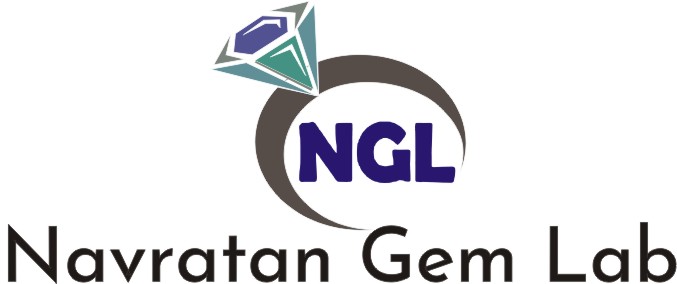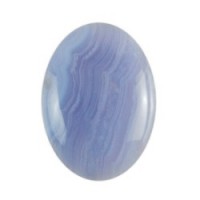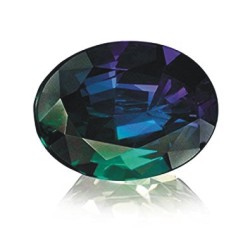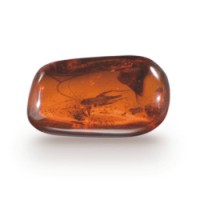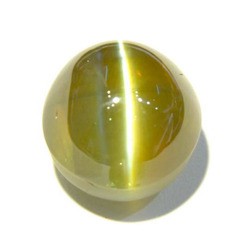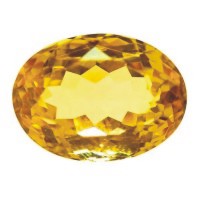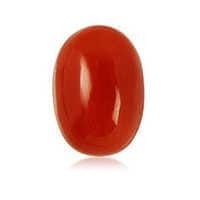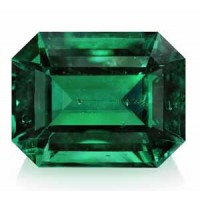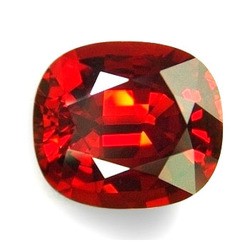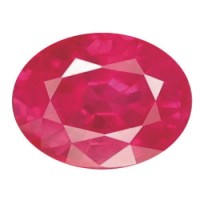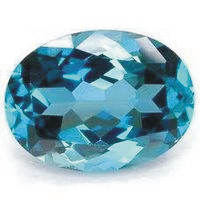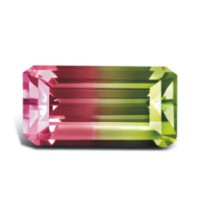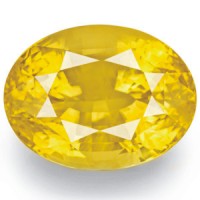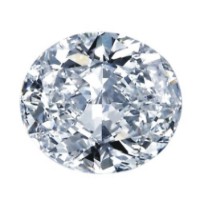Gallery
|
Agate is a banded form of finely-grained, microcrystalline Quartz. The lovely color patterns and banding make this translucent gemstone very unique. Agates can have many distinctive styles and patterns, but each Agate is unique in its own habit, with no two Agates being the same.Agate is generally an inexpensive gemstone when used in jewelry. It is cut and polished into cabochons, and used as beads for necklaces and bracelets. It is also carved into cameos which can be worn as pendants. Agate makes an exquisite ornamental stone, and is cut into slabs, animal carvings, ornate book ends, and small statues and figures.
A generally accepted requirement in the definition of Agate is that it has to be banded. This qualification distinguishes it from other forms of Chalcedony which are not banded. Exceptions include Dendritic Agate and Moss Agate, which are not true Agates since they lack the banding patterns, but they are still traditionally called Agates since they have more than one color. Onyx, when banded white and black, is technically a form of Agate, and Sardonyx, which is a banded reddish and white Chalcedony, is also technically a type of Agate. Some forms of Carnelian may also exhibit banding and can therefore be classified as both Carnelian and Agate. Sources: Agate deposits exist in Brazil, Argentina, Uruguay, Mexico, Poland, Botswana, India, Australia, and the United States (Oregon, Arizona, Montana, Wyoming, South Dakota, and Michigan). Similar Gemstones: The banding habit of Agate can distinguish it from most gemstones. Purple Fluorite known as Blue John may be banded, but it is much softer. The banded form of Calcite/Aragonite known as Travertine may also occur multicolored and be similar to Agate, but it too is much softer. |
||||||||||||||||||||||||||||||||||||||||||||||||||||
|
Alexandrite is the highly regarded color changing variety of Chrysoberyl. The color of Alexandrite changes under different lighting conditions. If viewed in daylight, its color is greenish blue to dark yellow-green. If viewed in incandescent or candle light, its color is pink to red. Alexandrite is a very rare and highly valuable gemstone, and until recently was extremely difficult to obtain due to its rarity. However, new sources in Brazil and Tanzania have made this gemstone available and more mainstream on the gemstone market.
The unique color change habit of Alexandrite is caused by slight impurities of the element chromium. The most desirable colors of Alexandrite are those that show a clearly visible pure hue color change, such as a pure green/blue in daylight to a pure red in incandescent light. Alexandrite is a rare and exquisite gemstone with outstanding color changing properties, and is most often faceted into round and cushion cuts that can bring out the best in its color. In jewelry, Alexandrite is used as rings and pendant centerpieces. Alexandrite in large sizes is extremely rare and valuable; most Alexandrite available is 2 carats or less. Alexandrite was originally discovered in the Sanarka River in the southern Ural Mountains of Russia. However, the Russian deposits have long since been exhausted, and Russian sources of Alexandrite are near impossible to obtain. Small deposits were subsequently found in Sri Lanka (Ceylon), and until the 1980's these were the only two sources of this rare gemstone. Since then, new deposits have been discovered in Brazil, Tanzania, and Madagascar, with the Brazilian sources being the most significant. Similar gemstones: The only other color changing gemstones are Color-change Garnet and Color-change Sapphire. Alexandrite is softer than Sapphire and harder then Garnet. |
||||||||||||||||||||||||||||||||||||||||||||||||||||
|
Amber is an organic gemstone, forming from the hardened resin of ancient pine trees. The hardening process of Amber is known as polymerization, which fossilizes the resin over many centuries and makes it hard and sturdy. Amber is formed from viscous, sticky resin, and therefore commonly contains inclusions that got stuck in the Amber and remained there when it hardened. These inclusions are usually of insects or plants, with the most well-known being mosquitoes. Amber with well-preserved organisms frozen internally are highly prized.
Amber is used in jewelry as cabochons and beads, and is used mostly for bracelets, necklaces, and earrings. Oval shapes and teardrops are also frequently cut from Amber. It is not commonly faceted into gemstone cuts. Ornamental carvings are occasionally also cut from larger Amber pieces. The world's largest Amber deposits are near the Baltic Sea in Kaliningrad Oblast, Russia, in the historical East Prussia. The nearby Baltic countries of Latvia and Lithuania are also important producers of Amber. Northern Poland, around the area of Gdansk, also along the Baltic Sea, is another important producer of Amber. Some of the Baltic Amber is extracted directly from the Baltic Sea, either washing up on shore or picked up from the ocean bed.
|
||||||||||||||||||||||||||||||||||||||||||||||||||||
|
Amethyst is one of the most popular gemstones, and has been considered valuable since ancient times. Its name derives from the Greek "amethystos", which means "not drunken", as Amethyst in antiquity was thought to ward off drunkenness.Amethyst colors range from light to dark purple, and the transparent deep purple colors are the most highly regarded.
Sources: Brazil is the largest producer of Amethyst. It is found there in the states of Minas Gerais, Rio Grande do Sul, Maraba and Bahia. Other important deposits are in Uruguay (in Artigas), Argentina, Bolivia, Mexico, Namibia, Zambia, South Africa, Madagascar, Canada (Ontario), and the United States (Arizona, North Carolina, Georgia, and Maine). A specific deposit of Amethyst known to produce the greenish Prasiolite variety upon heat treatment is the Montezuma Mine in Minas Gerais, Brazil. Similar Gemstones: The color of Amethyst is rather unique, and few gems are confused with it, especially in deeper shades. Purple Sapphire and Purple Spinel may be the same color of Amethyst, but these are both very rare and command much higher prices than Amethyst. Iolite may also be similar but has a bluer hue. Fluorite can have the same color, but its very low hardness limits its use as a gemstone and it is only used as a collectors gem.
|
||||||||||||||||||||||||||||||||||||||||||||||||||||
|
Blue Sapphire is the most precious and valuable gemstone. It is a very desirable gemstone due to its excellent color, hardness, durability, and luster. In the gem trade, Sapphire without any color prefix refers to the blue variety of the mineral Corundum. However, the term Sapphire encompasses all other gem varieties and colors of Corundum as well, excluding Ruby, the red variety of Corundum, which has its own name since antiquity. Sapphire is one of the most popular gemstones, and is used extensively in Jewelry. Fine colored Sapphire with a deep blue color and excellent transparency can reach several thousand dollars a carat. The blue variety is most often used in jewelry, but the yellow, pink, and orange "fancies" have recently become very popular. Green and light blue Sapphires are also known, but are less commonly used in jewelry. Opaque Black Sapphire is also used a minor gemstone.
Sapphire is one of the most popular gemstones, and is used extensively in Jewelry. Fine colored Sapphire with a deep blue color and excellent transparency can reach several thousand dollars a carat. The blue variety is most often used in jewelry, but the yellow, pink, and orange "fancies" have recently become very popular. Green and light blue Sapphires are also known, but are less commonly used in jewelry. Opaque Black Sapphire is also used a minor gemstone. Sources: Important Sapphire sources include Sri Lanka, Burma (Myanmar), Thailand, Cambodia, Madagascar, Tanzania, Australia, and the U.S. (Montana). The Kashmir region of India/Pakistan was famous for its Kashmir-blue Sapphire, but little material comes from there today. Similar Gemstones: Iolite, blue Tourmaline, and blue Zircon may resemble blue Sapphire, but are softer. The other color varieties of Sapphire are commonly confused with many gemstones, but their great hardness can distinguish them. |
||||||||||||||||||||||||||||||||||||||||||||||||||||
|
Cat's Eye describes a gemstone polished into a cabochon that displays a narrow band of concentrated light going accross the width of the stone. This effect, known as chatoyancy, or cat's eye effect, is caused by inclusions of fine, slender parallel mineral fibers in the gemstone that reflect light in a single band. Of all the gemstones that exhibit cat's eye, Chrysoberyl Cat's Eye is the best known. Chrysoberyl has the strongest and most distinct cat's eye effect of all gemstones. Though several different gemstones types exhibit a cat's eye effect, only Chrysoberyl's cat's eye enjoys the privilege of having the name "Cat's Eye" without any prefix. Whenever the term "Cat's Eye" is used, it refers to Chrysoberyl cat's eye by default, unless otherwise specified.
Other Cat's Eye gemstones include Cat's Eye Tourmaline, Cat's Eye Quartz, Cat's Eye Aquamarine, Cat's Eye Moonstone, Cat's Eye Apatite, and Cat's Eye Scapolite. Of all these other Cat's Eye Gemstones, Chrysoberyl has the greatest hardness. Sources: Cat's Eye sources are in Brazil, India, China, and Zimbabwe.
|
||||||||||||||||||||||||||||||||||||||||||||||||||||
|
Chalcedony is the form of Quartz that is compact and microcrystalline. It occurs in many different forms, colors, and patterns, and many varieties have been used as gemstones since antiquity. In the gemstone trade, the term Chalcedony is often used specifically to describe the white, gray, or blue translucent type of Chalcedony, but its technical term includes all additional varieties.
Chalcedony is found in all types of colors, and its varieties are named based on color. The variety Agate is a multicolored form, well known for its distinctive banding patterns. Some forms of Chalcedony, such as Chrysoprase, are intensely colored, while others are light. In blue Chalcedony, the deeper the color, the more desirable the gemstone. The classic Chalcedony varieties are described below:
|
||||||||||||||||||||||||||||||||||||||||||||||||||||
|
Chrysoberyl is a hard, tough, and durable gem. Although lacking the fire of other gemstones, Chrysoberyl in its various forms can be quite valuable. Most Chrysoberyl gems are yellow, though some are brown, green, or orange. Chrysoberyl is best known for its important varieties Alexandrite and Cat's Eye. Alexandrite is a rare and expensive form that exhibits different colors in natural and artificial light. Cat's Eye is Chrysoberyl that is polished into a cabochon and highly chatoyant, displaying a sharp line of light through the center of the stone.
Chrysoberyl is most often a lightly colored gemstone, though increased color saturation will increase its value. Chrysoberyl gemstones are often free of flaws, though stones larger than several carats are uncommon. With a hardness of 8½, Chrysoberyl is also one of the hardest gemstones. Source: The most significant Chrysoberyl deposits are in Brazil, but other important deposits are in Australia, Madagascar, Zimbabwe, Myanmar (Burma), and Russia. Cat's eye is found in Brazil, India, China, Sri Lanka, and Zimbabwe, and Alexandrite comes from Brazil, Russia, Madagascar, Sri Lanka and Tanzania. Similar Gemstones: Topaz, Heliodor, Peridot, Yellow Sapphire, Citrine, and Zircon may resemble Chrysoberyl. Chrysoberyl Cat's eye can be distinguished from other cat's eye gemstone by its greater hardness. |
||||||||||||||||||||||||||||||||||||||||||||||||||||
|
Citrine is the yellow to orange variety of Quartz.The name Citrine is derived from the citron fruit, a yellow fruit similar to the lemon. (In fact, citron means "lemon" in several languages.)
Sources: Brazil is the largest producer of Citrine. Other sources are Argentina, Madagascar, Zaire, Namibia, Spain, and Russia. Similar Gemstones: Citrine can be difficult to distinguish from yellow and orange Topaz. Citrine may also be confused with yellow Sapphire, which is usually a purer yellow and much harder, and can also be confused with Golden Beryl known as Heliodor. Some Grossular Garnets may also have a similar color to orange-red Citrine.
|
||||||||||||||||||||||||||||||||||||||||||||||||||||
|
Unlike most other gemstones which are of mineral origin, Coral is organic, formed by living organisms. It forms from branching, antler-like structures created from coral polyps in tropical and subtropical ocean waters. When the coral polyps die, the hardened skeleton remains, and this material is what is used as a gemstone. Most coral is white, but nature can create coral in several other colors, including the popular orange to red forms. This Red Coral, or Precious Coral as it is often known by, is the most used gemstone form of Coral. In fact, the color known as coral is derived from the typical pinkish-orange color of many red Coral gemstones.
Coral is used as cabochons and beads. It is also sculpted into small carvings such as flowers for pins and brooches. Small branches of Coral are sometimes stranded into spiky, dangling necklaces. Sources: Coral is found only in tropical to subtropical saltwater environments. Regions producing coral include the Red Sea, the Midway Islands, the Canary Islands, the Taiwan and Malaysian Coast, the coast of Australia, Italy, (Sardinia), and Hawaii. Similar Gemstones: Red Coral may be confused with Carnelian, which is much harder. White Coral may be confused with Ivory. |
||||||||||||||||||||||||||||||||||||||||||||||||||||
|
Diamond, the most famed and fabled of all gemstones, is very unique in many ways. Renowned for being the hardest substance on earth, its sparkling fire, durability, and rarity make Diamond the most prized of all gems. No gemstone contains as much allure and interest as does Diamond.
A grading system was implemented to evaluate Diamonds based on four aspects. These four grading systems are known as "the four C's", in which all Diamonds are evaluated: Color:
Sources: Diamond production varies year by year, for example huge quantities of Diamonds have recently been coming from Botswana, while the large deposits of Australia are no longer productive. As of 2010, the top ten Diamond producing countries, which account for over 80 percent of the worlds Diamonds, are Russia, Botswana, Congo, Angloa, South Africa, Namibia, Guinea, Ghana, Australia, and Canada (a relatively recent producer). Similar Gemstones: Many gemstones resemble Diamond. However, few have the adamantine luster and fire like that of Diamond, and they are all softer than Diamond. Many synthetic materials are also made to closely resemble diamond, such as YAG (Yttrium Aluminum Garnet), Strontium Titanate, Moissanite, and of course Cubic Zirconia, Diamond's main imposter. However, Diamond is distinguished from all the others by its immense hardness |
||||||||||||||||||||||||||||||||||||||||||||||||||||
|
Emerald the green variety of Beryl, is the most popular green gemstone and is one of the most valuable gems. Beryl is a single mineral with many varieties that are distinguished by their color. Few other minerals have so many known varieties specifically identified by their color. Many of the Beryl varieties are very important gemstones. In fact, all the transparent varieties of Beryl have been used as gemstones, although Emerald and Aquamarine are by far the most important and well-known varieties. All Beryl varieties are faceted into various gem cuts, especially Emerald and Aquamarine, which are one of the most popular jewelry gemstones.
Pure Beryl is colorless; traces of different impurities are responsible for the color diversity and varieties. The list below describes each color variety, and most have a link for more specific gemstone information for that variety:
Sources: South America (Columbia; Brazil), Africa (Zambia, Nigeria,Zimbabwe, Tanzania, Transvaal, Mozambique, Madagascar), Pakistan (Swat), Afghanistan (Pancher), India (Rajasthan, Orissa), Russia, Austria, Australia. Similar Gemstones: Gemstones resembling Emerald are Fluorite, Apatite, Dioptase, Aventurine Quartz, Glass. |
||||||||||||||||||||||||||||||||||||||||||||||||||||
|
Hessonite is one of the variety of Garnet Family. Garnet is not a single mineral, but describes a group of several closely related minerals. Garnets come in a variety of colors and have many different varieties. However, the most widely-known color of Garnet gemstones is dark red. When the term "Garnet" is used, it is usually connotative of the dark red form; other color Garnets are usually given more descriptive gemstone terms.
Sources: Srilanka, India, Myanmar(Burma),Madagascar. Similar Gemstones: The gemstone similar to hessonite are Yellow Beryl, Natural Zircon,Sapphire,Topaz,Etc. |
||||||||||||||||||||||||||||||||||||||||||||||||||||
|
|
||||||||||||||||||||||||||||||||||||||||||||||||||||
|
Opal is the most colorful of gems. Its splendid play of color is unsurpassed, and fine examples can even be more valuable than Diamond. The play of color consists of iridescent color flashes that change with the angle at which the stone is viewed. This phenomenon is often called opalescence. The play of color may consist of large, individual flashes of color (known as schillers), or may be of tiny, dense flashes. The intensity and distribution of the color flashes is a determining factor in the value of an Opal.
Precious Opals are cut and polished into cabochons and used in all forms of jewelry, especially as pendants and ring centerpieces. Fire Opals are faceted into several gemstone cuts for jewelry. Boulder Opal is also a popular form which is used as jewelery, especially as cabochons. Opal, especially Common Opal, can also be carved into small ornamental figures. Sources: Australia is the largest producer of Opal. Other important deposits are in Ethiopia, Sudan, Hungary, Honduras, Brazil, Mexico, and the United States (Nevada, Oregon, California, Idaho). The play of color exhibited in Opal is distinctive, and no natural gemstones can duplicate Precious Opal. Similar Gemstones: Fire Opal may be similar to Topaz, Citrine, and Carnelian.
|
||||||||||||||||||||||||||||||||||||||||||||||||||||
|
Pearls have been highly valued as gemstones since antiquity, and their allure and beauty has always been magnified by the difficulty of obtaining them in early times. Unlike most other gemstones which are minerals, Pearls are organic and are formed by living organisms. They are generally formed within the soft tissue layer of mollusks such as oysters and mussels. Pearls are composed of calcium carbonate (in the form of Aragonite) and organic conchiolin that build up as concentric layers as they are secreted by their host.
Pearls are among the most popular gemstones and have been used since antiquity. All colors and types of Pearl are used as gemstones, and they are especially popular as necklaces. Pearls are also extensively used as bracelets, and can also be the center stone in rings, earrings, and pendants. Pendants are often made of non-rounded Pearls such a baroque-shaped Pearls. Sources: Most Saltwater Pearl culturing takes place in the Indian and South Pacific Oceans. Pearls are primarily cultured in China, Japan, the Philippines, Indonesia, Burma (Myanmar) Australia, and in French Polynesia (especially Tahiti). Freshwater Pearls are cultured primarily in China and Japan and in several states in the U.S
|
||||||||||||||||||||||||||||||||||||||||||||||||||||
|
Rhodochrosite has a lovely natural pink to red color. Rhodochrosite gemstones are primarily translucent to opaque banded beads and cabochons. These bands are often in concentric or zigzag patterns of alternating white and pink (or red) colors. The transparent red forms large enough to be cut into gemstones are extremely valuable and cherished by rare gemstone connoisseurs.
Though Rhodochrosite has a very pretty color, it is not a durable gemstone because of its low hardness. It is easily scratched, and care must be ensured to preserve it. Much of the banded form of Rhodochrosite comes from Argentina, where the Rhodochrosite forms as stalagmites and stalactites in ancient Inca Silver mines and caves. Sources: Most gemstone Rhodochrosite originates in Catamarca, Argentina. The Sweet Home Mine in Colorado and the Wudong Mine in China have produced gemmy clear Rhodochrosite. Other sources include South Africa, Peru, and Japan. Similar Gemstones: Rhodonite is much harder and usually contains black banding, and Thulite is harder.
|
||||||||||||||||||||||||||||||||||||||||||||||||||||
|
Rhodonite is an inexpensive pink gemstone. It often has impurities of black manganese oxide dendrite veins running through it, creating interesting formations and providing a nice contrast. The name Rhodonite is derived from the term rhodos, which is Greek for "Rose colored".
Rhodonite is polished into beads and cabochons, and is used in necklaces, bracelets, and pendants. It is occasionally carved into ornamental objects, ornate tiles, and small statues. The deep pink to red transparent forms are occasionally faceted as rare gemstones. Sources: Sources of gem Rhodonite are Russia, Australia, Japan, Madagascar, Sweden, Brazil, and Peru. Rhodonite also comes from the U.S. at New Jersey and Massachusetts. Similar Gemstones: Rhodochrosite is much softer and usually contains white banding, and Thulite lacks the black manganese oxide dendrites and inclusions. |
||||||||||||||||||||||||||||||||||||||||||||||||||||
|
Ruby is distinguished for its bright red color, being the most famed and fabled red gemstone. Beside for its bright color, it is a most desirable gem due to its hardness, durability, luster, and rarity. Transparent rubies of large sizes are even rarer than Diamonds. Ruby is the red variety of the mineral Corundum. Sapphire, the other gem variety of Corundum, encompasses all colors of Corundum aside from red. In essence, Ruby is a red Sapphire, since Ruby and Sapphire are identical in all properties except for color. However, because of the special allure and historical significance, Ruby has always been classified as an individual gemstone, and is never identified as a form of Sapphire (though some purplish-red colors may straddle the line of being classified as either Ruby or Sapphire). Sources:
In 2000, new Ruby sources were discovered in Madagascar (in Vatomandry and Andilamena). These deposits turned out to be very extensive and productive, and Madagascar is now one of the leaders in Ruby output. Other important Ruby sources include Sri Lanka, India, Cambodia, Vietnam, Tanzania, and Mozambique. Other sources of Ruby include Afghanistan, Pakistan, Tajikstan, Australia, and the U.S. (North Carolina). Similar Gemstones: Ruby is identical in appearance to Spinel. In fact, many old famous red gemstones thought to be Rubies were determined to actually be Spinel. Ruby and Spinel often occur together in the same mineral environment and localities. The most famous ruby, the Black Prince's Ruby, set into the royal crown of England, was once thought to be the largest cut Ruby, until scientific analysis determined it to be in fact Spinel. Garnet (particularly Pyrope) and red Tourmaline (Rubellite) may also resemble Ruby, though Ruby is significantly harder. |
||||||||||||||||||||||||||||||||||||||||||||||||||||
|
Spinel is most famous for its deep red variety that closely resembles Ruby. These two gemstones can be very difficult to distinguish. Until the late 19th century, there was no distinction made between Ruby and red Spinel, as they look identical and are found in the same localities. Many famous old "Rubies" were discovered to be in fact Spinel. For example, the enormous "Ruby" that forms the centerpiece of the royal crown of England (the Black Prince's Ruby) was actually determined to be Spinel.
Spinel is a gemstone that comes in a variety of colors. Pure Spinel is colorless, but impurities are responsible for the wide range of colors. The most valuable and desirable Spinel color is a deep blood red, though blue, yellow, orange, pink, and purple colors also make fine gemstones. Spinel is often fluorescent in ultraviolet light, and this can be helpful in its identification. Sources: The most outstanding Spinel in size, color, and quality is from Burma. Other sources of gem Spinel are Sri Lanka, Cambodia, Vietnam, Thailand, Tadjikistan, Afghanistan, Pakistan, Tanzania, and Madagascar. Similar Gemstones: Red Spinel can be identical in appearance to Ruby. However, Spinel is usually lighter in color, and the deep-red Spinel is usually more of a brick-red then the Red of Ruby which has a slight blue or purple tinge to it. However, only optical properties and hardness can truly distinguish these two gemstones. Red Spinel can also closely resemble red Tourmaline and dark red Spinel may resemble Garnet. |
||||||||||||||||||||||||||||||||||||||||||||||||||||
|
Topaz makes an ideal gem. A good hardness and desirable colors, combined with a relative abundance and availability makes it one the most popular gemstones. The most valuable colors of Topaz are the golden orange-yellow type, called Imperial Topaz, and the dark pinkish-red and orange-red colors. Value increases with a deepness of color in orange and reddish hues. The most commonly used colors of Topaz in jewelry are the blue types. It was not until this past century that blue Topaz became widespread on the gem market, since virtually all blue gem Topaz is irradiated and heat treated.
Topaz is a fairly common and inexpensive gemstone. It can be found in huge and flawless crystals, which can be faceted into giant gemstones which can weigh thousands of carats. Some of the largest gemstone pieces ever cut were of Topaz. Sources: The largest Topaz producer is Brazil. Other sources are in Pakistan, Afghanistan, India, China, Burma (Myanmar), Sri Lanka, Japan, Russia, Ukraine, Australia, Madagascar, Namibia, Nigeria, Zimbabwe, Mexico, and the U.S. (California, Utah, and New Hampshire). |
||||||||||||||||||||||||||||||||||||||||||||||||||||
|
Tourmaline is the most colorful of all gemstones. It occurs in all colors, but pink, red, green, blue and multicolored are its most well-known gem colors. Scientifically, tourmaline is not a single mineral, but a group of minerals related in their physical and chemical properties. The mineral Elbaite is the member of the Tourmaline group that is responsible for almost all the gem varieties.
The most expensive and valuable form of Tourmaline is the rare neon-blue form known by the trade name Paraiba Tourmaline. Paraiba Tourmaline was first discovered in a gem pegmatite in the Brazilian state of Paraiba in 1989. This new Tourmaline became extremely popular in a very short time, and the cost for this rare Tourmaline became astronomically high due to short supply. Small deposits of Tourmaline of similar color to Paraiba Tourmaline were also recently found in Nigeria and Mozambique, and these are often also called "Paraiba Tourmaline" in the gem trade. Other valuable forms of Tourmaline are Chrome Tourmaline, an intense-green Tourmaline found in Tanzania, Rubellite, the pink to red variety, and Indicolite, the rare blue variety. Sources: Important deposits of Tourmaline are in Afghanistan, Pakistan, Russia, Burma (Myanmar), Sri Lanka (Ceylon), and the United States (California and Maine). Several African countries have recently become big producers of gem Tourmaline, specifically Madagascar, Namibia, Mozambique, Tanzania, Nigeria, and Malawi. |
||||||||||||||||||||||||||||||||||||||||||||||||||||
|
Yellow sapphire is variety of corundum.Sapphire often contains minor inclusions of tiny slender Rutile needles. When present, these inclusions decrease the transparency of a stone and are known as silk. When in dense, parallel groupings, these inclusions can actually enhance by allowing polished Sapphires to exhibit asterism. Sapphire gems displaying asterism are known as "Star Sapphire", and these can be highly prized. Star Sapphire exists in six ray stars, though twelve ray stars are also known. Sapphire is pleochroic, displaying a lighter and more intense color when viewed at different angles. Some pleochroic Sapphire is blue when viewed at one angle, and purple at a different angle. Color zoning, which forms from growth layers that build up during the formation of the stone, may also be present in certain Sapphires. Color zoning is responsible for certain Sapphires having lighter and darker colors in different parts of a crystal. Some Sapphire gemstones may even be multicolored such as purple and blue. Besides for the varieties of Sapphire listed below, Sapphire with color other than Yellow are prefixed with their color names. The main gemstone colors in addition to Yellow Sapphire include:
Sapphire is usually heat treated to intensify the blue color, as well as remove inclusions to increase clarity. It is standard industry practice to heat treat Sapphire gemstones, and most Sapphires used as gemstones have been heat treated. Sapphire with a natural, unheated color is much more valuable then the heat treated material, and gemstones of good quality can be extremely costly. Sapphires are sometimes colored through diffusion treatment, which artificially alters the color of the original gemstone. Diffused Sapphires colors include deep blue, bright yellow, bright orange and orange-red. The diffusion is often done by heat treating a stone in a beryllium metal overlay. Diffused Sapphire gemstones are fairly inexpensive despite their desirable color. Because of all the color treatments and enhancements performed to Sapphire gemstones, this information should always be fully disclosed to the buyer, and Sapphire should only be purchased from highly reputable dealers. Sources: Important Sapphire sources include Sri Lanka, Burma (Myanmar), Thailand, Cambodia, Madagascar, Tanzania, Australia, and the U.S. (Montana). The Kashmir region of India/Pakistan was famous for its Kashmir-blue Sapphire, but little material comes from there today. Similar Gemstones: Citrine, Yellow Topaz, Yellow Beryl, Chrysoberyl etc. |
||||||||||||||||||||||||||||||||||||||||||||||||||||
|
Zircon is an important gemstone of many colors, and is an historical gemstone used for thousands of years. It is sometimes looked upon as a cheap Diamond simulant, but in actuality it can be a valuable gem. Its color diversity is caused by traces of certain impurities, some of which are radioactive. Zircon gemstones containing radioactive element traces undergo a process called metamiction, in which their inner crystal structure becomes destroyed. These radioactive forms of Zircon must be heated to stabilize them for use as gems. In fact, many of the gem forms of zircon (even those that are not radioactive) are heat treated to enhance color and increase transparency.
Zircon comes closer to resembling Diamond than any other natural gem. Its strong luster and intense fire gives it a real sparkle that is comparable to Diamond. However, its popularity is somewhat diminished by the fact that it is often perceived as an inexpensive Diamond imitation. Colorless Zircon is easily distinguished from Diamond by its strong double refraction and lower hardness. Sources: Zircon sources include Cambodia, Burma (Myanmar), Sri Lanka (Ceylon), Australia, Tanzania, Mozambique, Madagascar, Nigeria, Pakistan, and Afghanistan. |
|
Agate is a banded form of finely-grained, microcrystalline Quartz. The lovely color patterns and banding make this translucent gemstone very unique. Agates can have many distinctive styles and patterns, but each Agate is unique in its own habit, with no two Agates being the same.Agate is generally an inexpensive gemstone when used in jewelry. It is cut and polished into cabochons, and used as beads for necklaces and bracelets. It is also carved into cameos which can be worn as pendants. Agate makes an exquisite ornamental stone, and is cut into slabs, animal carvings, ornate book ends, and small statues and figures.
A generally accepted requirement in the definition of Agate is that it has to be banded. This qualification distinguishes it from other forms of Chalcedony which are not banded. Exceptions include Dendritic Agate and Moss Agate, which are not true Agates since they lack the banding patterns, but they are still traditionally called Agates since they have more than one color. Onyx, when banded white and black, is technically a form of Agate, and Sardonyx, which is a banded reddish and white Chalcedony, is also technically a type of Agate. Some forms of Carnelian may also exhibit banding and can therefore be classified as both Carnelian and Agate. Sources: Agate deposits exist in Brazil, Argentina, Uruguay, Mexico, Poland, Botswana, India, Australia, and the United States (Oregon, Arizona, Montana, Wyoming, South Dakota, and Michigan). Similar Gemstones: The banding habit of Agate can distinguish it from most gemstones. Purple Fluorite known as Blue John may be banded, but it is much softer. The banded form of Calcite/Aragonite known as Travertine may also occur multicolored and be similar to Agate, but it too is much softer. |
Alexandrite is the highly regarded color changing variety of Chrysoberyl. The color of Alexandrite changes under different lighting conditions. If viewed in daylight, its color is greenish blue to dark yellow-green. If viewed in incandescent or candle light, its color is pink to red. Alexandrite is a very rare and highly valuable gemstone, and until recently was extremely difficult to obtain due to its rarity. However, new sources in Brazil and Tanzania have made this gemstone available and more mainstream on the gemstone market.
The unique color change habit of Alexandrite is caused by slight impurities of the element chromium. The most desirable colors of Alexandrite are those that show a clearly visible pure hue color change, such as a pure green/blue in daylight to a pure red in incandescent light. Alexandrite is a rare and exquisite gemstone with outstanding color changing properties, and is most often faceted into round and cushion cuts that can bring out the best in its color. In jewelry, Alexandrite is used as rings and pendant centerpieces. Alexandrite in large sizes is extremely rare and valuable; most Alexandrite available is 2 carats or less. Alexandrite was originally discovered in the Sanarka River in the southern Ural Mountains of Russia. However, the Russian deposits have long since been exhausted, and Russian sources of Alexandrite are near impossible to obtain. Small deposits were subsequently found in Sri Lanka (Ceylon), and until the 1980's these were the only two sources of this rare gemstone. Since then, new deposits have been discovered in Brazil, Tanzania, and Madagascar, with the Brazilian sources being the most significant. Similar gemstones: The only other color changing gemstones are Color-change Garnet and Color-change Sapphire. Alexandrite is softer than Sapphire and harder then Garnet. |
Amber is an organic gemstone, forming from the hardened resin of ancient pine trees. The hardening process of Amber is known as polymerization, which fossilizes the resin over many centuries and makes it hard and sturdy. Amber is formed from viscous, sticky resin, and therefore commonly contains inclusions that got stuck in the Amber and remained there when it hardened. These inclusions are usually of insects or plants, with the most well-known being mosquitoes. Amber with well-preserved organisms frozen internally are highly prized.
Amber is used in jewelry as cabochons and beads, and is used mostly for bracelets, necklaces, and earrings. Oval shapes and teardrops are also frequently cut from Amber. It is not commonly faceted into gemstone cuts. Ornamental carvings are occasionally also cut from larger Amber pieces. The world's largest Amber deposits are near the Baltic Sea in Kaliningrad Oblast, Russia, in the historical East Prussia. The nearby Baltic countries of Latvia and Lithuania are also important producers of Amber. Northern Poland, around the area of Gdansk, also along the Baltic Sea, is another important producer of Amber. Some of the Baltic Amber is extracted directly from the Baltic Sea, either washing up on shore or picked up from the ocean bed.
|
Amethyst is one of the most popular gemstones, and has been considered valuable since ancient times. Its name derives from the Greek "amethystos", which means "not drunken", as Amethyst in antiquity was thought to ward off drunkenness.Amethyst colors range from light to dark purple, and the transparent deep purple colors are the most highly regarded.
Sources: Brazil is the largest producer of Amethyst. It is found there in the states of Minas Gerais, Rio Grande do Sul, Maraba and Bahia. Other important deposits are in Uruguay (in Artigas), Argentina, Bolivia, Mexico, Namibia, Zambia, South Africa, Madagascar, Canada (Ontario), and the United States (Arizona, North Carolina, Georgia, and Maine). A specific deposit of Amethyst known to produce the greenish Prasiolite variety upon heat treatment is the Montezuma Mine in Minas Gerais, Brazil. Similar Gemstones: The color of Amethyst is rather unique, and few gems are confused with it, especially in deeper shades. Purple Sapphire and Purple Spinel may be the same color of Amethyst, but these are both very rare and command much higher prices than Amethyst. Iolite may also be similar but has a bluer hue. Fluorite can have the same color, but its very low hardness limits its use as a gemstone and it is only used as a collectors gem.
|
||||||||||||||||||||||||||||||||||||||||||||||||||||||||||||||||||||||||||||||||||||||||||||||||||||||||||||||||||||
|
Blue Sapphire is the most precious and valuable gemstone. It is a very desirable gemstone due to its excellent color, hardness, durability, and luster. In the gem trade, Sapphire without any color prefix refers to the blue variety of the mineral Corundum. However, the term Sapphire encompasses all other gem varieties and colors of Corundum as well, excluding Ruby, the red variety of Corundum, which has its own name since antiquity. Sapphire is one of the most popular gemstones, and is used extensively in Jewelry. Fine colored Sapphire with a deep blue color and excellent transparency can reach several thousand dollars a carat. The blue variety is most often used in jewelry, but the yellow, pink, and orange "fancies" have recently become very popular. Green and light blue Sapphires are also known, but are less commonly used in jewelry. Opaque Black Sapphire is also used a minor gemstone.
Sapphire is one of the most popular gemstones, and is used extensively in Jewelry. Fine colored Sapphire with a deep blue color and excellent transparency can reach several thousand dollars a carat. The blue variety is most often used in jewelry, but the yellow, pink, and orange "fancies" have recently become very popular. Green and light blue Sapphires are also known, but are less commonly used in jewelry. Opaque Black Sapphire is also used a minor gemstone. Sources: Important Sapphire sources include Sri Lanka, Burma (Myanmar), Thailand, Cambodia, Madagascar, Tanzania, Australia, and the U.S. (Montana). The Kashmir region of India/Pakistan was famous for its Kashmir-blue Sapphire, but little material comes from there today. Similar Gemstones: Iolite, blue Tourmaline, and blue Zircon may resemble blue Sapphire, but are softer. The other color varieties of Sapphire are commonly confused with many gemstones, but their great hardness can distinguish them. |
Cat's Eye describes a gemstone polished into a cabochon that displays a narrow band of concentrated light going accross the width of the stone. This effect, known as chatoyancy, or cat's eye effect, is caused by inclusions of fine, slender parallel mineral fibers in the gemstone that reflect light in a single band. Of all the gemstones that exhibit cat's eye, Chrysoberyl Cat's Eye is the best known. Chrysoberyl has the strongest and most distinct cat's eye effect of all gemstones. Though several different gemstones types exhibit a cat's eye effect, only Chrysoberyl's cat's eye enjoys the privilege of having the name "Cat's Eye" without any prefix. Whenever the term "Cat's Eye" is used, it refers to Chrysoberyl cat's eye by default, unless otherwise specified.
Other Cat's Eye gemstones include Cat's Eye Tourmaline, Cat's Eye Quartz, Cat's Eye Aquamarine, Cat's Eye Moonstone, Cat's Eye Apatite, and Cat's Eye Scapolite. Of all these other Cat's Eye Gemstones, Chrysoberyl has the greatest hardness. Sources: Cat's Eye sources are in Brazil, India, China, and Zimbabwe.
|
Chalcedony is the form of Quartz that is compact and microcrystalline. It occurs in many different forms, colors, and patterns, and many varieties have been used as gemstones since antiquity. In the gemstone trade, the term Chalcedony is often used specifically to describe the white, gray, or blue translucent type of Chalcedony, but its technical term includes all additional varieties.
Chalcedony is found in all types of colors, and its varieties are named based on color. The variety Agate is a multicolored form, well known for its distinctive banding patterns. Some forms of Chalcedony, such as Chrysoprase, are intensely colored, while others are light. In blue Chalcedony, the deeper the color, the more desirable the gemstone. The classic Chalcedony varieties are described below:
|
Chrysoberyl is a hard, tough, and durable gem. Although lacking the fire of other gemstones, Chrysoberyl in its various forms can be quite valuable. Most Chrysoberyl gems are yellow, though some are brown, green, or orange. Chrysoberyl is best known for its important varieties Alexandrite and Cat's Eye. Alexandrite is a rare and expensive form that exhibits different colors in natural and artificial light. Cat's Eye is Chrysoberyl that is polished into a cabochon and highly chatoyant, displaying a sharp line of light through the center of the stone.
Chrysoberyl is most often a lightly colored gemstone, though increased color saturation will increase its value. Chrysoberyl gemstones are often free of flaws, though stones larger than several carats are uncommon. With a hardness of 8½, Chrysoberyl is also one of the hardest gemstones. Source: The most significant Chrysoberyl deposits are in Brazil, but other important deposits are in Australia, Madagascar, Zimbabwe, Myanmar (Burma), and Russia. Cat's eye is found in Brazil, India, China, Sri Lanka, and Zimbabwe, and Alexandrite comes from Brazil, Russia, Madagascar, Sri Lanka and Tanzania. Similar Gemstones: Topaz, Heliodor, Peridot, Yellow Sapphire, Citrine, and Zircon may resemble Chrysoberyl. Chrysoberyl Cat's eye can be distinguished from other cat's eye gemstone by its greater hardness. |
||||||||||||||||||||||||||||||||||||||||||||||||||||||||||||||||||||||||||||||||||||||||||||||||||||||||||||||||||||
|
Citrine is the yellow to orange variety of Quartz.The name Citrine is derived from the citron fruit, a yellow fruit similar to the lemon. (In fact, citron means "lemon" in several languages.)
Sources: Brazil is the largest producer of Citrine. Other sources are Argentina, Madagascar, Zaire, Namibia, Spain, and Russia. Similar Gemstones: Citrine can be difficult to distinguish from yellow and orange Topaz. Citrine may also be confused with yellow Sapphire, which is usually a purer yellow and much harder, and can also be confused with Golden Beryl known as Heliodor. Some Grossular Garnets may also have a similar color to orange-red Citrine.
|
Unlike most other gemstones which are of mineral origin, Coral is organic, formed by living organisms. It forms from branching, antler-like structures created from coral polyps in tropical and subtropical ocean waters. When the coral polyps die, the hardened skeleton remains, and this material is what is used as a gemstone. Most coral is white, but nature can create coral in several other colors, including the popular orange to red forms. This Red Coral, or Precious Coral as it is often known by, is the most used gemstone form of Coral. In fact, the color known as coral is derived from the typical pinkish-orange color of many red Coral gemstones.
Coral is used as cabochons and beads. It is also sculpted into small carvings such as flowers for pins and brooches. Small branches of Coral are sometimes stranded into spiky, dangling necklaces. Sources: Coral is found only in tropical to subtropical saltwater environments. Regions producing coral include the Red Sea, the Midway Islands, the Canary Islands, the Taiwan and Malaysian Coast, the coast of Australia, Italy, (Sardinia), and Hawaii. Similar Gemstones: Red Coral may be confused with Carnelian, which is much harder. White Coral may be confused with Ivory. |
Diamond, the most famed and fabled of all gemstones, is very unique in many ways. Renowned for being the hardest substance on earth, its sparkling fire, durability, and rarity make Diamond the most prized of all gems. No gemstone contains as much allure and interest as does Diamond.
A grading system was implemented to evaluate Diamonds based on four aspects. These four grading systems are known as "the four C's", in which all Diamonds are evaluated: Color:
Sources: Diamond production varies year by year, for example huge quantities of Diamonds have recently been coming from Botswana, while the large deposits of Australia are no longer productive. As of 2010, the top ten Diamond producing countries, which account for over 80 percent of the worlds Diamonds, are Russia, Botswana, Congo, Angloa, South Africa, Namibia, Guinea, Ghana, Australia, and Canada (a relatively recent producer). Similar Gemstones: Many gemstones resemble Diamond. However, few have the adamantine luster and fire like that of Diamond, and they are all softer than Diamond. Many synthetic materials are also made to closely resemble diamond, such as YAG (Yttrium Aluminum Garnet), Strontium Titanate, Moissanite, and of course Cubic Zirconia, Diamond's main imposter. However, Diamond is distinguished from all the others by its immense hardness |
Emerald the green variety of Beryl, is the most popular green gemstone and is one of the most valuable gems. Beryl is a single mineral with many varieties that are distinguished by their color. Few other minerals have so many known varieties specifically identified by their color. Many of the Beryl varieties are very important gemstones. In fact, all the transparent varieties of Beryl have been used as gemstones, although Emerald and Aquamarine are by far the most important and well-known varieties. All Beryl varieties are faceted into various gem cuts, especially Emerald and Aquamarine, which are one of the most popular jewelry gemstones.
Pure Beryl is colorless; traces of different impurities are responsible for the color diversity and varieties. The list below describes each color variety, and most have a link for more specific gemstone information for that variety:
Sources: South America (Columbia; Brazil), Africa (Zambia, Nigeria,Zimbabwe, Tanzania, Transvaal, Mozambique, Madagascar), Pakistan (Swat), Afghanistan (Pancher), India (Rajasthan, Orissa), Russia, Austria, Australia. Similar Gemstones: Gemstones resembling Emerald are Fluorite, Apatite, Dioptase, Aventurine Quartz, Glass. |
||||||||||||||||||||||||||||||||||||||||||||||||||||||||||||||||||||||||||||||||||||||||||||||||||||||||||||||||||||
|
Hessonite is one of the variety of Garnet Family. Garnet is not a single mineral, but describes a group of several closely related minerals. Garnets come in a variety of colors and have many different varieties. However, the most widely-known color of Garnet gemstones is dark red. When the term "Garnet" is used, it is usually connotative of the dark red form; other color Garnets are usually given more descriptive gemstone terms.
Sources: Srilanka, India, Myanmar(Burma),Madagascar. Similar Gemstones: The gemstone similar to hessonite are Yellow Beryl, Natural Zircon,Sapphire,Topaz,Etc. |
|
Opal is the most colorful of gems. Its splendid play of color is unsurpassed, and fine examples can even be more valuable than Diamond. The play of color consists of iridescent color flashes that change with the angle at which the stone is viewed. This phenomenon is often called opalescence. The play of color may consist of large, individual flashes of color (known as schillers), or may be of tiny, dense flashes. The intensity and distribution of the color flashes is a determining factor in the value of an Opal.
Precious Opals are cut and polished into cabochons and used in all forms of jewelry, especially as pendants and ring centerpieces. Fire Opals are faceted into several gemstone cuts for jewelry. Boulder Opal is also a popular form which is used as jewelery, especially as cabochons. Opal, especially Common Opal, can also be carved into small ornamental figures. Sources: Australia is the largest producer of Opal. Other important deposits are in Ethiopia, Sudan, Hungary, Honduras, Brazil, Mexico, and the United States (Nevada, Oregon, California, Idaho). The play of color exhibited in Opal is distinctive, and no natural gemstones can duplicate Precious Opal. Similar Gemstones: Fire Opal may be similar to Topaz, Citrine, and Carnelian.
|
Pearls have been highly valued as gemstones since antiquity, and their allure and beauty has always been magnified by the difficulty of obtaining them in early times. Unlike most other gemstones which are minerals, Pearls are organic and are formed by living organisms. They are generally formed within the soft tissue layer of mollusks such as oysters and mussels. Pearls are composed of calcium carbonate (in the form of Aragonite) and organic conchiolin that build up as concentric layers as they are secreted by their host.
Pearls are among the most popular gemstones and have been used since antiquity. All colors and types of Pearl are used as gemstones, and they are especially popular as necklaces. Pearls are also extensively used as bracelets, and can also be the center stone in rings, earrings, and pendants. Pendants are often made of non-rounded Pearls such a baroque-shaped Pearls. Sources: Most Saltwater Pearl culturing takes place in the Indian and South Pacific Oceans. Pearls are primarily cultured in China, Japan, the Philippines, Indonesia, Burma (Myanmar) Australia, and in French Polynesia (especially Tahiti). Freshwater Pearls are cultured primarily in China and Japan and in several states in the U.S
|
||||||||||||||||||||||||||||||||||||||||||||||||||||||||||||||||||||||||||||||||||||||||||||||||||||||||||||||||||||
|
Rhodochrosite has a lovely natural pink to red color. Rhodochrosite gemstones are primarily translucent to opaque banded beads and cabochons. These bands are often in concentric or zigzag patterns of alternating white and pink (or red) colors. The transparent red forms large enough to be cut into gemstones are extremely valuable and cherished by rare gemstone connoisseurs.
Though Rhodochrosite has a very pretty color, it is not a durable gemstone because of its low hardness. It is easily scratched, and care must be ensured to preserve it. Much of the banded form of Rhodochrosite comes from Argentina, where the Rhodochrosite forms as stalagmites and stalactites in ancient Inca Silver mines and caves. Sources: Most gemstone Rhodochrosite originates in Catamarca, Argentina. The Sweet Home Mine in Colorado and the Wudong Mine in China have produced gemmy clear Rhodochrosite. Other sources include South Africa, Peru, and Japan. Similar Gemstones: Rhodonite is much harder and usually contains black banding, and Thulite is harder.
|
Rhodonite is an inexpensive pink gemstone. It often has impurities of black manganese oxide dendrite veins running through it, creating interesting formations and providing a nice contrast. The name Rhodonite is derived from the term rhodos, which is Greek for "Rose colored".
Rhodonite is polished into beads and cabochons, and is used in necklaces, bracelets, and pendants. It is occasionally carved into ornamental objects, ornate tiles, and small statues. The deep pink to red transparent forms are occasionally faceted as rare gemstones. Sources: Sources of gem Rhodonite are Russia, Australia, Japan, Madagascar, Sweden, Brazil, and Peru. Rhodonite also comes from the U.S. at New Jersey and Massachusetts. Similar Gemstones: Rhodochrosite is much softer and usually contains white banding, and Thulite lacks the black manganese oxide dendrites and inclusions. |
Ruby is distinguished for its bright red color, being the most famed and fabled red gemstone. Beside for its bright color, it is a most desirable gem due to its hardness, durability, luster, and rarity. Transparent rubies of large sizes are even rarer than Diamonds. Ruby is the red variety of the mineral Corundum. Sapphire, the other gem variety of Corundum, encompasses all colors of Corundum aside from red. In essence, Ruby is a red Sapphire, since Ruby and Sapphire are identical in all properties except for color. However, because of the special allure and historical significance, Ruby has always been classified as an individual gemstone, and is never identified as a form of Sapphire (though some purplish-red colors may straddle the line of being classified as either Ruby or Sapphire). Sources:
In 2000, new Ruby sources were discovered in Madagascar (in Vatomandry and Andilamena). These deposits turned out to be very extensive and productive, and Madagascar is now one of the leaders in Ruby output. Other important Ruby sources include Sri Lanka, India, Cambodia, Vietnam, Tanzania, and Mozambique. Other sources of Ruby include Afghanistan, Pakistan, Tajikstan, Australia, and the U.S. (North Carolina). Similar Gemstones: Ruby is identical in appearance to Spinel. In fact, many old famous red gemstones thought to be Rubies were determined to actually be Spinel. Ruby and Spinel often occur together in the same mineral environment and localities. The most famous ruby, the Black Prince's Ruby, set into the royal crown of England, was once thought to be the largest cut Ruby, until scientific analysis determined it to be in fact Spinel. Garnet (particularly Pyrope) and red Tourmaline (Rubellite) may also resemble Ruby, though Ruby is significantly harder. |
Spinel is most famous for its deep red variety that closely resembles Ruby. These two gemstones can be very difficult to distinguish. Until the late 19th century, there was no distinction made between Ruby and red Spinel, as they look identical and are found in the same localities. Many famous old "Rubies" were discovered to be in fact Spinel. For example, the enormous "Ruby" that forms the centerpiece of the royal crown of England (the Black Prince's Ruby) was actually determined to be Spinel.
Spinel is a gemstone that comes in a variety of colors. Pure Spinel is colorless, but impurities are responsible for the wide range of colors. The most valuable and desirable Spinel color is a deep blood red, though blue, yellow, orange, pink, and purple colors also make fine gemstones. Spinel is often fluorescent in ultraviolet light, and this can be helpful in its identification. Sources: The most outstanding Spinel in size, color, and quality is from Burma. Other sources of gem Spinel are Sri Lanka, Cambodia, Vietnam, Thailand, Tadjikistan, Afghanistan, Pakistan, Tanzania, and Madagascar. Similar Gemstones: Red Spinel can be identical in appearance to Ruby. However, Spinel is usually lighter in color, and the deep-red Spinel is usually more of a brick-red then the Red of Ruby which has a slight blue or purple tinge to it. However, only optical properties and hardness can truly distinguish these two gemstones. Red Spinel can also closely resemble red Tourmaline and dark red Spinel may resemble Garnet. |
||||||||||||||||||||||||||||||||||||||||||||||||||||||||||||||||||||||||||||||||||||||||||||||||||||||||||||||||||||
|
Topaz makes an ideal gem. A good hardness and desirable colors, combined with a relative abundance and availability makes it one the most popular gemstones. The most valuable colors of Topaz are the golden orange-yellow type, called Imperial Topaz, and the dark pinkish-red and orange-red colors. Value increases with a deepness of color in orange and reddish hues. The most commonly used colors of Topaz in jewelry are the blue types. It was not until this past century that blue Topaz became widespread on the gem market, since virtually all blue gem Topaz is irradiated and heat treated.
Topaz is a fairly common and inexpensive gemstone. It can be found in huge and flawless crystals, which can be faceted into giant gemstones which can weigh thousands of carats. Some of the largest gemstone pieces ever cut were of Topaz. Sources: The largest Topaz producer is Brazil. Other sources are in Pakistan, Afghanistan, India, China, Burma (Myanmar), Sri Lanka, Japan, Russia, Ukraine, Australia, Madagascar, Namibia, Nigeria, Zimbabwe, Mexico, and the U.S. (California, Utah, and New Hampshire). |
Tourmaline is the most colorful of all gemstones. It occurs in all colors, but pink, red, green, blue and multicolored are its most well-known gem colors. Scientifically, tourmaline is not a single mineral, but a group of minerals related in their physical and chemical properties. The mineral Elbaite is the member of the Tourmaline group that is responsible for almost all the gem varieties.
The most expensive and valuable form of Tourmaline is the rare neon-blue form known by the trade name Paraiba Tourmaline. Paraiba Tourmaline was first discovered in a gem pegmatite in the Brazilian state of Paraiba in 1989. This new Tourmaline became extremely popular in a very short time, and the cost for this rare Tourmaline became astronomically high due to short supply. Small deposits of Tourmaline of similar color to Paraiba Tourmaline were also recently found in Nigeria and Mozambique, and these are often also called "Paraiba Tourmaline" in the gem trade. Other valuable forms of Tourmaline are Chrome Tourmaline, an intense-green Tourmaline found in Tanzania, Rubellite, the pink to red variety, and Indicolite, the rare blue variety. Sources: Important deposits of Tourmaline are in Afghanistan, Pakistan, Russia, Burma (Myanmar), Sri Lanka (Ceylon), and the United States (California and Maine). Several African countries have recently become big producers of gem Tourmaline, specifically Madagascar, Namibia, Mozambique, Tanzania, Nigeria, and Malawi. |
Yellow sapphire is variety of corundum.Sapphire often contains minor inclusions of tiny slender Rutile needles. When present, these inclusions decrease the transparency of a stone and are known as silk. When in dense, parallel groupings, these inclusions can actually enhance by allowing polished Sapphires to exhibit asterism. Sapphire gems displaying asterism are known as "Star Sapphire", and these can be highly prized. Star Sapphire exists in six ray stars, though twelve ray stars are also known. Sapphire is pleochroic, displaying a lighter and more intense color when viewed at different angles. Some pleochroic Sapphire is blue when viewed at one angle, and purple at a different angle. Color zoning, which forms from growth layers that build up during the formation of the stone, may also be present in certain Sapphires. Color zoning is responsible for certain Sapphires having lighter and darker colors in different parts of a crystal. Some Sapphire gemstones may even be multicolored such as purple and blue. Besides for the varieties of Sapphire listed below, Sapphire with color other than Yellow are prefixed with their color names. The main gemstone colors in addition to Yellow Sapphire include:
Sapphire is usually heat treated to intensify the blue color, as well as remove inclusions to increase clarity. It is standard industry practice to heat treat Sapphire gemstones, and most Sapphires used as gemstones have been heat treated. Sapphire with a natural, unheated color is much more valuable then the heat treated material, and gemstones of good quality can be extremely costly. Sapphires are sometimes colored through diffusion treatment, which artificially alters the color of the original gemstone. Diffused Sapphires colors include deep blue, bright yellow, bright orange and orange-red. The diffusion is often done by heat treating a stone in a beryllium metal overlay. Diffused Sapphire gemstones are fairly inexpensive despite their desirable color. Because of all the color treatments and enhancements performed to Sapphire gemstones, this information should always be fully disclosed to the buyer, and Sapphire should only be purchased from highly reputable dealers. Sources: Important Sapphire sources include Sri Lanka, Burma (Myanmar), Thailand, Cambodia, Madagascar, Tanzania, Australia, and the U.S. (Montana). The Kashmir region of India/Pakistan was famous for its Kashmir-blue Sapphire, but little material comes from there today. Similar Gemstones: Citrine, Yellow Topaz, Yellow Beryl, Chrysoberyl etc. |
Zircon is an important gemstone of many colors, and is an historical gemstone used for thousands of years. It is sometimes looked upon as a cheap Diamond simulant, but in actuality it can be a valuable gem. Its color diversity is caused by traces of certain impurities, some of which are radioactive. Zircon gemstones containing radioactive element traces undergo a process called metamiction, in which their inner crystal structure becomes destroyed. These radioactive forms of Zircon must be heated to stabilize them for use as gems. In fact, many of the gem forms of zircon (even those that are not radioactive) are heat treated to enhance color and increase transparency.
Zircon comes closer to resembling Diamond than any other natural gem. Its strong luster and intense fire gives it a real sparkle that is comparable to Diamond. However, its popularity is somewhat diminished by the fact that it is often perceived as an inexpensive Diamond imitation. Colorless Zircon is easily distinguished from Diamond by its strong double refraction and lower hardness. Sources: Zircon sources include Cambodia, Burma (Myanmar), Sri Lanka (Ceylon), Australia, Tanzania, Mozambique, Madagascar, Nigeria, Pakistan, and Afghanistan. |
